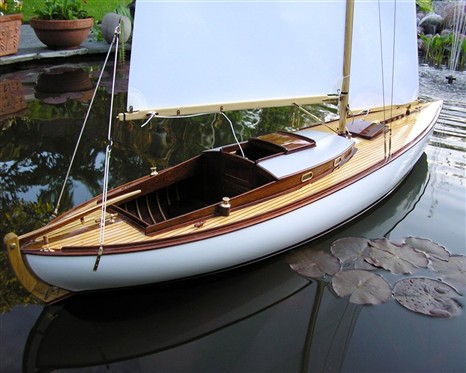Reimers “Tumlaren” Specifications:
LOA: 27’3 / 8.31m * LOD: 27’3 / 8.31m * LWL: 21’10 / 6.65m * Beam: 6’3 / 1.91m * Draft: 4’4 / 1.32m * Ballast: 2,040 / 925 kgs * Displacement: 3,970lbs / 1,801kgs * Sail Area: 215.3 ft2 / 20 sqm * Yard Number: * Hull Material: Composite with Steel Frames * Rig: Sloop * Designer: Reimers * Built by: * Year Built: 1934 * Restored By: * Current Name: * Original Owner: * Current Owner: * Sail Number:
From the weblog Knockabout Sloops:
I have been rereading Lin and Larry Pardey’s “Seraffyn’s European Adventure” and I came across this description of one of Larry’s early boats, a Knud Reimers’ Tumlaren, that he raced and cruised when he lived in Vancouver.
When Larry was nineteen he’d fallen in love with a twenty-seven foot Tumlaren class sloop designed by Knud Reimers and called Annalisa. She’d been built by the Kungsor yard near Stockholm in 1948 for the crown prince of Denmark. By taking a bank loan, countersigned by his father, Larry had been able to buy the completely varnished sloop and for five years he raced and cruised her around Vancouver. From the time I met him, two years after he sold Annalisa, Larry had raved about his magnificent sloop. I’d almost grown jealous for Seraffyn as he described the extreme lightweight, scientific construction of the narrow, delicate Tumlaren. Seraffyn is twenty four feet four inches long with a beam of nine feet, and weighs close to eleven thousand pounds. Annalisa, at twenty seven feet on deck, was only six feet and displaced only thirty eight hundred pounds. As we cruised north through Sweden’s multitude of islands I came to appreciate the ideas behind the Tumlaren’s design. She, like the much better know Folkboat class, had been created for families who had protected waters to sail in. From a hundred fifty miles south of Stockolm north to Finland and east to Helsinki, a stretch of over six hundred miles, there are so many islands and anchorages that there is never a need to be more than four or five miles from land. The islands keep the seas flat with only occasional chop. Tiny villages dot the archipelagos so a family cruiser need carry only a few day’s worth of supplies. But the intricate passages around the rocks and islands require boats that are handy to tack and close winded, boats that accelerate quickly to use each puff of wind that whispers around the points and trees. These boats are built light to save money since they can only be used three or four months out of the year. We saw hundreds of them throughout Sweden and Denmark, and many are sailed without engines.

